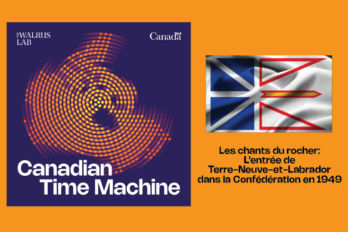SHOW NOTES:
SOURCES USED IN THIS EPISODE
The music for this episode is a licensed version of “This Podcast Theme” by InPlus Music. Additional music are licensed versions of “Stay Cool” by Loops Lab, “Podcast Intro” by InPlus Music, “Ethereal Relaxation” by Kevin MacLeod, “Impact Prelude” by Kevin MacLeod, and “Screen Saver” by Kevin MacLeod.
LINKS MENTIONED IN THIS EPISODE:
ADDITIONAL LINKS:
TRANSCRIPT:
SHEENA ROSSITER: Welcome to Deep Dive, a weekly podcast that takes a deeper look into the happenings at The Walrus.
I’m Sheena Rossiter.
ANGELA MISRI: And I’m Angela Misri.
On this week’s episode.
AUDIO CLIP (DR. TEDROS ADHANOM GHEBREYESUS): WHO has been assessing this outbreak around the clock, and we are deeply concerned, both by the alarming levels of spread and severity, and by the alarming levels of inaction. We have therefore made the assessment that COVID-19 can be characterized as a pandemic.
ANGELA MISRI: It was a moment that most people won’t forget any time soon. Just over two years ago today, the COVID-19 virus was declared a pandemic.
SHEENA ROSSITER: It was on March 11, 2020 when Dr. Tedros Adhanom Ghebreyesus, the Director General of The World Health Organization, took to the microphone at a press conference in Geneva to make this declaration–saying that this was the first time a coronavirus had sparked a pandemic.
ANGELA MISRI: Most of us were stunned, and our lives would be forever changed. The world seemingly went into lockdown overnight, masks and hand sanitizer became commonplace accessories in most households, and the term social distancing became part of our vocabulary. Now two years into the pandemic, many of us are still wondering: when will this pandemic end?
SHEENA ROSSITER: This week, we’ll be speaking with Dan Werb. He’s an award-winning writer and epidemiologist whose work has appeared in The New York Times, Salon, The Believer, and The Walrus, among other places. His latest book, The Invisible Siege: The Rise of Coronaviruses and the Search for a Cure, chronicles the emergence of coronavirus science across multiple epidemics. And we recently ran an excerpt of it at thewalrus.ca
ANGELA MISRI: And you had the chance to speak with Dan recently about his book on the history of human coronaviruses, but also about when this pandemic could end, and how we can get back to “normal”.
SHEENA ROSSITER: Here’s my conversation with Dan Werb.
SHEENA ROSSITER: We’re about two years into the pandemic now and, are we turning a corner with this pandemic? Is it coming to an end finally?
DAN WERB: That’s a great question. And I think anybody who says that they have a definite answer on that is overconfident. What we do know is that the virus is going to continue to evolve, and hopefully it will evolve to become milder and less virulent, but that’s not something that we can take for granted. The one thing that would truly hasten the end of the pandemic is an increase in global vaccine equity. People talk about this like it’s some grand moral beacon, but really, it’s the most selfish thing that we can do in the context of a pandemic. The fact is, we need global herd immunity to stop transmission cycles among vulnerable populations. So variants are going to emerge when there are populations that are vulnerable to infection. When the virus can cycle its way through a population, it’s going to mutate and cause new variants.
And so the way we stop those variants, which weaken the vaccines, and thereby put all of us at greater risk, is by increasing the access we have to vaccines across the world. So it’s actually one of the rare cases where the most selfish thing, the most selfish path, is actually also the most ethical path, which is making sure the vaccines are available everywhere.
AUDIO CLIP (GLOBAL NEWS): Third dose booster shots are beginning to ramp up across the country. In Ontario, those aged 50 and over can get their boosters starting December 13th. That will bring the number eligible for third doses to more than 5 million. We want to be able to provide the third doses in a timely fashion before the immunity fades.
SHEENA ROSSITER: And hasn’t Canada been really bad when it came to hoarding vaccines? Don’t we have enough vaccines here that we can vaccinate the population five times over?
DAN WERB: It’s a strange situation, where it seems like, okay, yes, we want to move as quickly as possible to protect Canadians. So we want to make sure that we have third dose boosters, maybe fourth dose boosters and on and on and on. But really, a commitment to getting those vaccines out to low-income countries, where only about 10% of the population is vaccinated two years into this pandemic, is going to do so much more to protect us in the long term, than getting Canadians third, fourth, fifth dose boosters.
SHEENA ROSSITER: Why write a book about this, about the history of human coronaviruses and the way scientists have tried to understand and stop them?
DAN WERB: It grew out of this effort for me to put what I describe in the book as putting parameters on my anxiety, or putting parameters on our collective anxiety. I wanted to explore what was known about coronaviruses and what kinds of scientific discoveries had been made both in the past and into this pandemic, to understand, what are the worst case scenarios and the best case scenarios, and how has the existence of previous coronaviruses spurred the science here? And what I discovered is just, these incredible scientists and these incredible personalities that have been, in some cases, working on coronaviruses since the 1980s, when there was literally like 60 coronavirus experts in the entire world. And these were seen as a completely benign viral family.
And just to see the evolution of this scientific backwater into the most urgently required scientific discipline, that essentially determines the future of humanity, is a fascinating story. And it’s one that’s really driven by this small collection of people. It’s pretty remarkable.
SHEENA ROSSITER: You mentioned there the best case scenarios and the worst case scenarios. Dare I ask what the worst case scenario is here?
DAN WERB: I think so far, we’ve avoided the worst case scenarios. I think early on in the pandemic, the worst case scenario was, there would be no viable vaccine. It was certainly not a surefire thing for many of those who were amateur or semi-professional watchers of this pandemic unfolding. But one of the wonderful things that I discovered in researching this book is that, in point of fact, the emergence of these vaccines, like some deus ex machina from just a sudden revelation of these scientific miracles, actually was something that had been in the works for a very, very long time. There were these different disciplines that had nothing to do with each other, coronavirology on the one hand, and RNA technology on the other, and then vaccinology on the third. And they started merging actually 5, 10 years before the COVID-19 pandemic happened.
SHEENA ROSSITER: Because we hear about COVID-19 every day in the news, it was a surprise to learn that the study of coronavirus is something like a scientific backwater, like you were talking about. Can you walk us through why that is the case?
DAN WERB: The short answer is that, until 2002, when SARS, severe acute respiratory syndrome, emerged, there were no pathogenic human coronaviruses. Two human coronaviruses had been identified, and both of them caused common colds. Really not threatening at all. And there was nothing to suggest, in the makeup of coronaviruses, to the casual observer, that they could be capable of being a pathogenic threat. So at the time, they were more of a virological oddity, and the people that came into the field in the 1980s and the 1990s, came just in the spirit of abstract exploration. These were virologists who were just interested in science for science’s sake, for the most part, and we’re interested in just using coronaviruses as ways to understand more about viruses. And in the rare case, like the case of Ralph Baric, we’re really curious about a particular aspect of the coronavirus, which was their massive genomes. And these were questions that seemed to have nothing to do the future of humanity. And then of course, all of that changed when SARS emerged and revealed that coronaviruses could threaten humanity.
SHEENA ROSSITER: Well, it’s so interesting, because of this pandemic, a lot of these scientists have become rockstar scientists, so to speak. Everybody knows who Anthony Fauci is, as opposed to two years ago, they’d be like, “Anthony who?”
AUDIO CLIP (SETH MEYERS): Now, Dr. Fauci, I guess it probably is never good for the rest of us when you are being portrayed on Saturday Night Live. Is that safe?
AUDIO CLIP (ANTHONY FAUCI): That is true. When I’m on Saturday Night Live, it’s not good news for the health of the country.
SHEENA ROSSITER: Has this really brought some of these people who have been working on this for quite a while, has it brought their work more to the forefront in mainstream society and popular culture?
DAN WERB: Yeah. It certainly has, but like everything, it has brought them both the kudos and the celebration that their work deserves, but it has also unfortunately brought them a lot of ire as well. You have researchers that have been doggedly pursuing these questions about how viruses work, have been among a handful of people who have been warning us about a pandemic and the pandemic potential of coronaviruses, for decades. And unfortunately, in the more twisted corners of the internet, in the world of conspiracy theorists, they have become villains. It’s extremely difficult right now for a lot of these scientists, because as you say, nobody knew who they were. And frankly, a lot of them are happy working in obscurity, and work deciduously to not be in the glare of the media, the great work that they’ve done to prepare us, and help move forward. Things like vaccines and antiviral treatments that can be effective at preventing severe illness, that has been totally distorted and perverted, and transform themselves into these villains in the eyes of people who have just twisted the facts.
SHEENA ROSSITER: We’ll be right back.
BRETT POPPLEWELL: How do you deter someone with laws that they don’t think exist? I’m Brett Popplewell, and that question lingered with me after a national security expert gave me her analysis of what she saw going on in Ottawa last month. I spent much of the occupation reporting on a singular story for The Walrus that I hoped would make sense of what was actually on the street after it was gone. In the course of putting my story together, I spoke to protestors and residents, went in and out of what the police had called The Red Zone multiple times, and spent a lot of time on the phone. The story was fact checked by what I believe is the best team of fact checkers in the country. It took some time to verify every word, and you can support their work and mine by subscribing to The Walrus at thewalrus.ca/subscribe.
AUDIO CLIP (DR. TEDROS ADHANOM GHEBREYESUS): Two years later, more than 6 million people have died. Although reported cases and deaths are declining globally, and several countries have lifted restrictions, the pandemic is far from over.
SHEENA ROSSITER: Misinformation has played into a lot of this pandemic. How has misinformation worked its way into basically virology, unlike maybe 20 years ago where it wouldn’t have been as prevalent on say social media or the internet?
DAN WERB: It’s everywhere. Anthony Fauci put it really well in an interview with the New York Times. He was asked about this question, about this idea that SARS-CoV-2 was a synthetically created chimaera in a lab as a result of this very, very obscure issue around furin cleavage sites. And he was like, “Furin cleavage sites? There are people who are now talking to me about furin cleavage sites who have no idea what it even means for this to appear on a virus. Everybody is suddenly an expert when information and misinformation flows so fluidly. And all it takes is just a little bit of curation, and you can make it seem that we know so much about these viruses.” And frankly, what I learned in writing this book is about how little even the greatest experts, even the greatest minds working on coronaviruses, knew about how they functioned.
It sounds odd, but even if somebody wanted to make a deadly pandemic-causing coronavirus pathogen, there’s no sense of how you would even start to do that. There are so many parts of the viral mechanisms that remain obscure, and that only came to light in the massive rush towards scholarship that happened after the emergence of the COVID-19 pandemic. It’s really absurd to just think that this was somehow related to human malice.
SHEENA ROSSITER: Now, parts of your book, it deals with government funding of research and the development of the limitations of “for profit science.” Has the pandemic had an impact on how we fund scientific research?
DAN WERB: Early on, it was like the spigot was just drinking from a fire hose. Everybody could get funded, it seemed, if they put COVID-19 in the name of their research project. Whether that has fundamentally changed the way that publicly-funded research happens remains to be seen. What I do know is that the way that market incentives operate, and the way that science is moved forward in a for-profit system has not fundamentally changed.
There was only one vaccine that was brought to market in the 50 years previous to the COVID-19 vaccines coming into play. Despite the fact, in the first 20 years of the 21st century, there were more novel pandemic potential pathogens that emerged than across the entire 20th century. Just to put that in plain language, we are seeing more dangerous viruses emerge now that the speed at which they’re emerging is accelerating, and at the same time, we’ve seen vaccinology essentially slow down to a halt in terms of getting vaccines to market. And that is completely related to these perverse market incentives that stipulate that companies and entities with funds are only going to work on vaccines if they are already a threat to the globe, or specifically to wealthy countries. If they’re only present in poor countries, and you think about emerging vaccines like Zika, Chikungunya, Ebola, these are pathogens that, in the case of Ebola, we have a potentially workable vaccine. But for the others, these are real threats to people’s health and lives, but there’s no market incentive to produce vaccines for that.
And so I don’t think that that perverse incentive structure has changed. We’ve got 10% of low income countries that even have access to these COVID-19 vaccines. So evidently, there’s something profoundly wrong with the way that these vaccines are produced and distributed.
SHEENA ROSSITER: Before COVID-19, there were a number of warnings that we were headed towards a pandemic. What do you think governments and health officials should have kept top of mind when it comes to future outbreaks?
DAN WERB: Two related considerations that need to be kept top of mind. The first is that we cannot predict what the next pathogen is going to emerge. And even if we know that it’s going to come from a specific family, we don’t know what it’s going to look like. But we do know that it is going to emerge. So that, on the one hand, puts governments in a quandary, because how do you prepare for a threat that you cannot identify, and yet you know is coming? Well, the best way to do that is to fund public science. Science that isn’t related, or doesn’t rely on an incentive structure that’s related to profit. Because you need science that is broad in scope, that is testing the boundaries of scientific knowledge, to make sure that all of the avenues of exploration are pursued, rather than only those avenues of exploration that are currently very important to us now, currently important to the market.
The story of career coronavirology is a really important one. It’s exemplary here. We had publicly funded coronavirus research that was happening since the 1980s, far, far, decades before it seemed like coronaviruses were a threat to humanity. And lo and behold, suddenly, 40 years later, we see a pandemic-causing coronavirus. Now, if that publicly funded, scientific discipline hadn’t existed before, and certainly, it wasn’t going to be funded by pharmaceutical or biotech industries. We would be so far behind where we are in terms of understanding this virus and producing vaccines and producing antivirals. It’s a case study in, you can’t predict what’s going to happen. You can’t predict what the next threat is going to be. So you better be publicly funding all the avenues of knowledge, without regard to what is currently most valuable on the market.
SHEENA ROSSITER: After writing this book, have you found reasons to be hopeful about defeating future pandemics?
DAN WERB: Absolutely. And the reason for hope are seeded in the research that started, again, in the 1980s and 1990s. There’s a wonderful through line in the book that charts the development of a series of antiviral treatments that were designed to be effective against multiple coronaviruses. These treatments were designed or started to be developed almost 10 years before COVID-19 emerged. And yet they are effective against the coronavirus that causes COVID-19. And what’s incredible is that their effectiveness was predicted even before SARS-CoV-2 emerged. And that prediction came true. There’s actually a pathway, and it’s a really beautiful story, of scientists who had a vision for the future, had a vision for how to protect humanity from future threats, and that prediction came true. And there’s no reason to think that that wouldn’t also hold for any future coronavirus pandemics as well. So that gives me a lot of hope.
SHEENA ROSSITER: Now, let’s check out what Dan is reading right now.
DAN WERB: I am currently reading Elias Canetti’s Crowds and Power. This is a seminal work, I’ve been told, of the 20th century. It’s this incredible exploration of crowds and crowd behaviour in and of itself. There’s no ethical or moral judgement put on a crowd. It’s just testing the theories about how crowds move and how they generate power and how people try to control them. And it is profoundly well written. It’s one of those books where every line you can just pull out and think about, and leaves you awe struck in the power of this person’s mind.
SHEENA ROSSITER: That’s my conversation with Dan Werb. The editor for his excerpt is Monica Warzecha. You can read an excerpt from his book, The Invisible Siege: The Rise of Coronaviruses and the Search for a Cure at thewalrus.ca right now.
WHAT WE’RE TALKING ABOUT THIS WEEK AT THE WALRUS:
EMMA MACKENZIE HILLIER: I’m Emma MacKenzie Hillier, and here’s what we’ve been talking about this week at The Walrus.
Since the war broke out in Ukraine, we’ve been fielding pitches from our contributors, but our longer form, fact-checked process means this week, we finally have a story to put out into the world on the crisis affecting so many. As part of our “Ask an Expert” series, we ask U of Ottawa professor Christina Clark-Kazak about how the war in Ukraine will impact immigration.
Meanwhile, our events team is having a busy week with two Walrus events – one you should be able to rewatch if you missed it and the second is this evening: The Walrus Leadership Forum: Technology and Treatment, which delves into the gaps in the Canadian mental health care system and the ways scientists are working to address them through innovative technology.
As always, the links for all these articles can be found in the show notes for this episode.
CREDITS:
SHEENA ROSSITER: Thanks for joining us on this week’s episode of the Deep Dive. It was produced by Angela Misri, and me, Sheena Rossiter. I also edited this episode.
Thanks so much to Dan Werb for joining us this week.
Music for this podcast is provided by Audio Jungle. Our theme song is This Podcast Theme by Inplus Music. Additional music is Stay Cool by Loops Lab, and Podcast Intro by Inplus Music. You also heard “Ethereal Relaxation,” “Impact Prelude,” and “Screen Saver” by Kevin MacLeod, provided by Film Music.
Impact Prelude by Kevin MacLeod
Link: https://incompetech.filmmusic.io/song/7565-impact-prelude
License: https://filmmusic.io/standard-license
Screen Saver by Kevin MacLeod
Link: https://incompetech.filmmusic.io/song/5715-screen-saver
License: https://filmmusic.io/standard-license
Ethereal Relaxation by Kevin MacLeod
Link: https://incompetech.filmmusic.io/song/8719-ethereal-relaxation
License: https://filmmusic.io/standard-license
Additional sources for this episode were provided by Global News, The World Health Organization, and Late Night with Seth Meyers on YouTube.
Don’t forget to subscribe to Deep Dive from The Walrus on Apple Podcasts, Spotify, or wherever you get your podcasts. And if you like what you heard, please leave us a review and rating. It really helps people find the podcast.
Until next week when we take our next deep dive.









